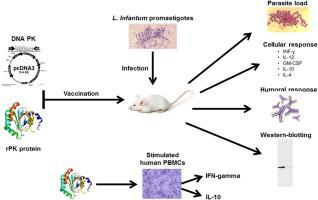Molecular Immunology ( IF 3.2 ) Pub Date : 2020-06-22 , DOI: 10.1016/j.molimm.2020.06.010 João A Oliveira-da-Silva 1 , Daniela P Lage 1 , Fernanda F Ramos 1 , Amanda S Machado 1 , Grasiele S V Tavares 1 , Débora V C Mendonça 1 , Isabela A G Pereira 1 , Vívian T Martins 1 , Lívia M Carvalho 2 , Fernanda Ludolf 1 , Thaís T O Santos 1 , Thiago A R Reis 1 , Camila S Oliveira 1 , Raquel S Bandeira 1 , Alessandra M Silva 1 , Lourena E Costa 1 , Jamil S Oliveira 3 , Mariana C Duarte 4 , Daniel Menezes-Souza 4 , Bruno M Roatt 2 , Antônio L Teixeira 5 , Eduardo A F Coelho 4

|
Leishmania infantum pyridoxal kinase (PK) protein was characterized after an immunoproteomics screening performed with the sera from patients suffering visceral leishmaniasis (VL). Since it was recognized by sera of mammalian hosts infected by a viscerotropic Leishmania species, PK could emerge as a new vaccine candidate against disease, due to its antigenicity and immunogenicity. In this context, in the present study, the effects of the immunization using PK were evaluated when administered as a DNA plasmid (pDNAA3/PK) or recombinant protein (rPK) plus saponin. The immune response elicited by both vaccination regimens reduced in significant levels the parasite load in spleen, liver, draining lymph nodes and bone marrow, being associated with the development of Th1-type immune response, which was characterized by high levels of IFN-γ, IL-12, GM-CSF, and specific IgG2a antibody, besides low production of IL-4, IL-10, and protein and parasite-specific IgG1 antibodies. CD8+ T cells were more important in the IFN-γ production in the pDNAA3/PK group, while CD4+ T cells contributed more significantly to production of this cytokine in the rPK/Saponin group. In addition, increased IFN-γ secretion, along with low levels of IL-10, were found when PBMCs from VL patients after treatment and healthy individuals were stimulated with the protein. In conclusion, when administered either as a DNA plasmid or recombinant protein plus adjuvant, PK can direct the immune response towards a Th1-type immune profile, protecting mice against L. infantum challenge; therefore, it can be seen as a promising immunogen against human VL.
中文翻译:

在重组蛋白和DNA疫苗中评估了婴儿利什曼原虫吡pyr醛激酶,可预防内脏利什曼病。
在对患有内脏利什曼病(VL)的患者的血清进行免疫蛋白质组学筛选后,对婴儿利什曼原虫吡pyr醛激酶(PK)蛋白进行了表征。由于它被内变利什曼原虫感染的哺乳动物宿主的血清所识别PK,由于其抗原性和免疫原性,可能成为抗疾病的新疫苗。在这种情况下,在本研究中,当以DNA质粒(pDNAA3 / PK)或重组蛋白(rPK)加皂苷的形式给药时,评估了使用PK进行免疫的效果。两种疫苗接种方案引发的免疫应答均显着降低了脾脏,肝脏,引流淋巴结和骨髓中的寄生虫负荷,这与Th1型免疫应答的发展有关,其特征是高水平的IFN-γ, IL-12,GM-CSF和特异性IgG2a抗体,以及IL-4,IL-10以及蛋白质和寄生虫特异性IgG1抗体的低产。CD8 + T细胞在pDNAA3 / PK组的IFN-γ产生中更为重要,而CD4 +在rPK / Saponin组中,T细胞对该细胞因子的产生贡献更大。此外,当用这种蛋白刺激VL患者和健康个体的PBMC后,发现该蛋白刺激了IFN-γ分泌的增加以及IL-10水平的降低。总之,当以DNA质粒或重组蛋白加佐剂的形式给药时,PK可以将免疫应答导向Th1型免疫谱,从而保护小鼠免受L侵害。婴儿挑战 因此,可以认为它是针对人VL的有希望的免疫原。











































 京公网安备 11010802027423号
京公网安备 11010802027423号